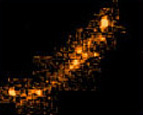Click on image for full size
NASA
A Long Time Ago in A Galaxy Far, Far Away...
News story originally written on August 1, 1997
A NASA Hubble Space Telescope (HST) image recently revealed the most distant galaxy found in the universe to date. Scientists had merely planned to take an image of the galaxy cluster CL138+62. But it was galaxy cluster CL138+62 that allowed scientists to see the new and distant galaxy.
You see, galaxy cluster CL138+62 acted as a lens (a gravitational lens to be more precise) for scientist to look through. Gravitational lenses were first predicted by Einstein's theory of relativity. These lenses are collections of material so massive that they warp the space around them which affects light coming from more distant objects. Looking through galaxy cluster CL138+62 caused the discovered galaxy's image to be brightened, magnified, and smeared into an arc-shape.
The newly discovered galaxy is distant indeed! Spectroscopic observations show that it is the farthest galaxy ever seen at a distance as far as 13 billion light-years away. Its light is reaching us now from a time when the universe was 7% of its current age (the universe is thought to be approximately 14 billion years old).
So what we see occurring in the galaxy actually occurred 13 billion years ago, or LONG ago during the formative years of galaxy birth. Many scientist hope that this will add to our knowledge of early galaxy formation and star birth within these young galaxies. In fact, Garth Illingworth of the University of California, Santa Cruz said, "We are fascinated to be witnessing the very early stages of the construction of what could well become a massive galaxy like our own Milky Way. This object is a pathfinder for deciphering what is happening in young galaxies, and offers a rare glimpse of the powerful events that transpired during the formation of galaxies."
The image was taken with Hubble's Wide Field Planetary Camera-2 on January 13, 1996. Many more exciting discoveries are expected from the orbiting telescope.















